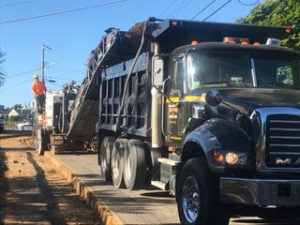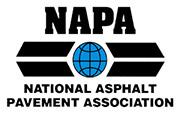Asphalt Pavement Rehab & Cost-Effectiveness
Asphalt Pavement Rehab & Cost-Effectiveness
 There comes a time in the life of every pavement when repairs are either impossible or too frequent and expensive to be cost-effective. At that point, the decision must be made whether to excavate and replace the pavement or rehabilitate it. Sometimes, the only option is to excavate and rebuild the pavement, but this can be costly and time-consuming. In many instances, asphalt pavement rehabilitation is more cost-effective and can be completed faster so that traffic disruption is minimized.
There comes a time in the life of every pavement when repairs are either impossible or too frequent and expensive to be cost-effective. At that point, the decision must be made whether to excavate and replace the pavement or rehabilitate it. Sometimes, the only option is to excavate and rebuild the pavement, but this can be costly and time-consuming. In many instances, asphalt pavement rehabilitation is more cost-effective and can be completed faster so that traffic disruption is minimized.
Asphalt Pavement Rehab & Cost-Effectiveness – What Is Pavement Rehabilitation?
Pavement rehabilitation typically involves paving an asphalt overlay over an existing pavement. The existing pavement can be asphalt or concrete, but the existing surface must be properly prepared. In addition, the surface preparation may need to address what caused the damage or distress to the previous pavement.
Asphalt Pavement Rehab & Cost-Effectiveness – What Are Overlays?
An asphalt overlay is a new tier of asphalt that is installed on top of what already exists. Properly installed, an overlay can provide a surface that looks and functions like new asphalt pavement. There are three basic types of overlays: thin lift, open-graded friction courses and structural. Thin lifts are the most common type of overlay chosen for pavements that have developed transverse, longitudinal or alligator cracks as well as pavements that show signs of rutting or raveling. Open-graded friction courses are used for asphalt pavements that display polished aggregate or flushing of asphalt binder, thereby increasing the risks of hydroplaning or skidding. Structural overlays are often used to bolster the pavement’s structural integrity; significant changes in the volume of heavily laden trucks may require a structural overlay, for example.
Asphalt Pavement Rehab & Cost-Effectiveness – What Are Surface Preparation Methods?
Existing problems that are not corrected will impact the performance of the overlay, so proper surface preparation is crucial to the performance of an overlay. Depending on the type and condition of the existing pavement, one or more of the following may be needed.
• Patching: Patching can repair alligator cracking and other localized damage. Patching may remove and replace just the surface course or the full depth of the pavement.
• Crack Repair: Longitudinal and transverse cracks should be sealed or filled to prevent them from “telegraphing” through the overlay.
• Asphalt Milling: Milling is a commonly used technique to prepare asphalt pavement for an overlay. The milling machine removes a precise depth of pavement and leaves a surface that can bond securely to the overlay.
• Reclamation: Full-depth reclamation is the in-place recycling of asphalt pavement and a designated amount of the foundation. Cold in-place recycling reclaims the existing materials to create a new base course.
• Concrete Preparation: If the existing pavement is concrete, special steps must be taken to prevent expansion joints and other cracks from showing through. Various methods can be used for this purpose.
If you need your pavement rehabilitated, contact the professionals at Dirtworks. We have delivered exceptional paving work to Cape Cod and Southeastern Massachusetts customers for over 20 years. We offer asphalt paving, reclamation, asphalt milling, asphalt repair, site work, sealcoating, parking lot striping, snow removal and dirt road repair to both residential and commercial customers. We are a locally owned company with an outstanding reputation for customer service and remarkable craftsmanship. For a free quote, call (508) 240-5541 or use our online form to send us your information.






